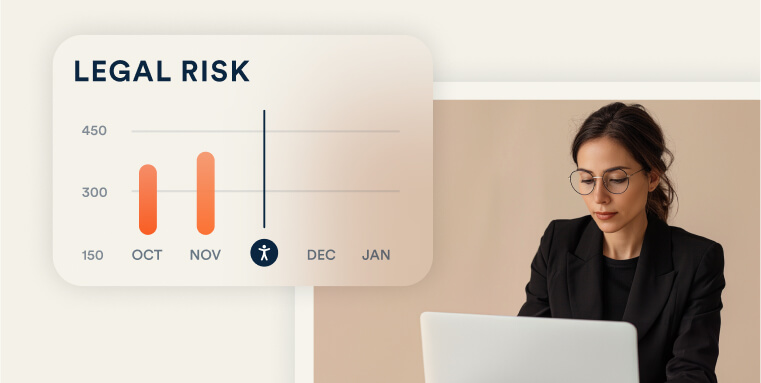The information presented within this guide is aimed at website owners seeking to learn the ropes of web accessibility and to create a more inclusive online environment for people with disabilities. Technical elements are described in layman’s terms, and, as a rule, all topics pertaining to the legalities of web accessibility are presented in as simplified a manner as possible. This blog has no legal bearing, and cannot be relied on in the case of litigation.
16% of the world’s population, including 28.7% of adult Americans, live with some form of disability.
At the same time, the vast majority of websites, web-based applications, and online environments in general are either partially or fully inaccessible to members of the various disability communities.
Businesses and organizations, regardless of size and industry, are now able to leverage powerful AI-driven technologies to help remedy this situation, and adjust their websites so that they are inclusive to all potential customers, regardless of ability.
And, as it turns out, embarking on an accessibility journey brings with it a number of significant benefits and advantages, as well.
In this blog, we will examine the benefits that come with making a true commitment to accessibility and inclusivity. We will show what businesses can stand to gain from implementing web accessibility tools and solutions within their websites and digital assets, and show the legal risk they will be mitigating by doing so.
Web accessibility significantly expands your audience and business reach
As mentioned above, members of the various disability communities account for huge sections of the world’s population:
Members of these groups are often denied access and entry to online businesses who they otherwise may have supported.
People with disabilities (and their extended families) command more than $13 trillion in expendable annual income. When you treat them with the respect they deserve, by presenting an accessible website, you allow them to explore your goods and services, and to potentially become your customer.
It is important to note that people with disabilities are like everyone else. They enjoy going on vacation just as much as abled people, for example, and spend an average of $52.8 billion a year on travel.
Additionally, given that eCommerce now accounts for 20% of all retail sales (a number that is expected to rise to 24% by 2025), it does not make sense for online store owners to deprive significant sections of the population from becoming their customers.
Bottom line: Accessible websites allow people with disabilities, a group consisting of more than 1.3 billion people, to examine your goods and services, and to potentially spend money on your business.
Investing in web accessibility can help you mitigate legal risk

Web accessibility is a legal requirement in many jurisdictions around the world.
In the U.S., most public facing businesses are required to make their online environments (including their websites) accessible, under the the Americans with Disabilities Act (ADA).
Businesses that fail to comply with the law in the form of presenting an accessible website are at risk of facing significant legal recourse, such as receiving a demand letter, and potentially facing ADA website compliance lawsuits.
The ADA is not the only American law that applies to websites and web accessibility. If you receive federal funding or provide services to such an organization, you need to comply with Section 508 of the Rehabilitation Act. Under the law, you need to ensure your website (as well as other information and communication technologies) are accessible to people with disabilities.
In Canada, many businesses are required to present accessible websites, under the Accessibility for Ontarioans with Disabilities Act (AODA). Failure to comply with the law can lead businesses to incur substantial monetary penalties, which you can avoid by investing in an accessibility solution.
In the United Kingdom, many organizations are legally mandated to present accessible websites, under laws such as The Equality Act of 2010, and The Public Sector Bodies (Websites and Mobile Applications) Accessibility Regulations 2018.
Bottom line: Investing in web accessibility and in web accessibility solutions will help you fulfill your legal obligations, and mitigate the legal risk you are exposed to.
Web accessibility improves SEO and can lead to higher rankings

Web accessibility has obvious benefits for people with disabilities, as it allows them to access websites and web-based applications they otherwise couldn’t. However, because many web accessibility practices overlap with SEO best practices, you can expect to see ranking-related benefits when investing in accessibility, as well.
For example, accessible websites must include descriptive alt text for meaningful images (e.g., infographics and other images that convey important information). While this helps screen reader users understand image content, it also allows search engines to better index the images, which can improve search visibility. Similarly, providing clear and structured headings, easy-to-navigate links, and well-defined metadata ensures both screen readers and search engines can interpret the content more effectively.
Accessible websites also tend to enhance overall user experience, which is a major factor in search engine rankings.
Websites that are easy to navigate and read—whether due to proper contrast, mobile responsiveness, or straightforward content—keep users engaged longer. This leads to lower bounce rates and can lead Google to prioritize it in relevant search engine result pages.
Additionally, Google continues to prioritize mobile-first indexing. As mobile responsiveness is a key component of accessible websites, you can expect your website to reap the SEO benefits that come with a highly responsive site, as well.
Bottom line: By investing in web accessibility, you not only create a better experience for people with disabilities, but also improve your website's SEO, leading to higher rankings, better visibility, and potentially more traffic.
An accessible website will allow you to appeal to modern, socially conscious consumers

Modern consumers increasingly consider the ethical stance of the companies they support. Corporate Social Responsibility (CSR) is no longer a novel concept, but rather a business imperative that can significantly impact consumer behavior.
Investing in web accessibility clearly demonstrates a commitment to inclusivity, fairness, and social good—values that resonate strongly with today’s socially conscious consumers.
Recent research shows that Corporate Social Responsibility initiatives have a direct influence on consumer decisions, with 87% of people stating they would purchase a product based on a company’s advocacy for a cause they care about.
Accessibility falls directly within the realm of CSR, as it ensures equal access to your digital products and services for everyone, regardless of ability.
Moreover, Corporate Social Responsibility isn't just about earning consumer favor; it also impacts brand loyalty.
The same research found that 67% of consumers are more likely to remain loyal to companies that are committed to social good. Presenting an accessible website strongly indicates that you are a brand with a strong commitment toward doing the right thing, and can position you to benefit from increased consumer loyalty.
Bottom line: Web accessibility is the very definition of Corporate Social Responsibility. When you invest in web accessibility and accessibility solutions, you appeal to modern consumers, who prefer to align themselves with socially conscious brands.
Start your accessibility journey now
An accessible website can be a major business generator, allowing you to appeal to new audiences and to outperform competitors who do not value accessibility. If you’d like to see how accessiBe can help you start your journey toward full accessibility, we encourage you to press here.
Frequently asked questions about the benefits of web accessibility
Q1. What are the main business benefits of making a website accessible?
A1. Accessible websites reach a wider audience, improve usability for all visitors, strengthen brand trust, and reduce legal and compliance risk. They also tend to convert better because users encounter fewer barriers during key actions like browsing, filling out forms, or completing purchases.
Q2. How does accessibility affect SEO and site performance?
A2. Many accessibility best practices—like clear headings, alternative text, descriptive links, and clean code—directly support SEO. Search engines can better understand and index content, which often leads to higher rankings, stronger engagement, and improved site performance overall.
Q3. Does accessibility help protect a business from legal issues?
A3. Yes. In the United States, websites are expected to be accessible under laws such as the ADA. Making your site accessible reduces the likelihood of facing demand letters or lawsuits and demonstrates a good-faith effort toward compliance.
Q4. How does accessibility improve brand reputation?
A4. Prioritizing accessibility shows that your organization values inclusivity and takes user experience seriously. This strengthens your brand, builds trust with customers, and can create a positive impression that lasts beyond a single interaction.
Q5. Are the benefits of accessibility only for people with disabilities?
A5. No. While accessibility is essential for people with disabilities, accessible design also makes websites easier to navigate, faster to use, and more intuitive for everyone. Better structure, clearer content, and more consistent interactions improve the experience for all users.
Q6. Why is it smarter to invest in accessibility proactively rather than reactively?
A6. Fixing accessibility issues early prevents costly redesigns and reduces compliance risk. Proactive investment also helps your business stay ahead of competitors, improve performance metrics, and provide a consistently positive experience as your digital presence grows.
Q7. Why is accessiBe a strong choice for organizations that want to realize these benefits?
A7. accessiBe offers end-to-end accessibility solutions that help organizations identify, fix, and maintain accessibility across their digital properties. With the best in AI and human expertise, accessiBe supports long-term compliance, improves site usability, and enables businesses to fully capture the performance, brand, and legal benefits of accessibility.





